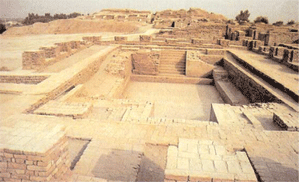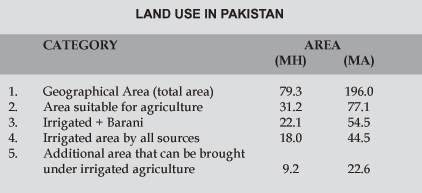Pakistan, a country of enchanting landscapes offers a combination of beaches, mountains, beautiful deserts and valleys. Its vast farm lands are sustained by the Indus Basin Irrigation System (IBIS), the largest contiguous irrigation system in the world. The IBIS irrigates 45 million acres of farm land which produces wheat, rice, fruits, vegetables, sugarcane, maize and cotton in abundance for local use as well as for export.
This report provides the historical context in which the IBIS was developed. It discusses the economic impact of the IBIS on Pakistan, and provides recommendations for some current problems related to insufficient drainage and inefficient farming practices.
Historical Background
The Indus Valley has been the host to one of the most ancient civilization of human history, the Indus Valley Civilization. After the extinction of the Indus Civilization, new settlements especially in doabs grew slowly. New irrigation systems started to evolve. Inundation canals and small dams were constructed and population grew all around this area. In order to reduce the occurrence of low irrigation water supply the British authorities, towards the middle of the last century, started modernizing and expanding the irrigation system of the Indus Basin.
Treaty Between Pakistan and India
In 1947, the Indian sub continent was partitioned by the British into two independent states – Pakistan and India. After the partition a commission was set up to resolve any issue that may emerge as a consequence of the partition. The matter of utilization of water resources of Indus Basin was raised by Pakistan. The boundary commission, chaired by Sir Cyril Radcliff, awarded control barrages (situated very close to the border) to India, while 90 percent of irrigated land lay in Pakistan.
After a protracted negotiation of ten years through facilitation of the World Bank, the Indus Basin Treaty was signed by India and Pakistan in 1960 for distribution of water resources in the Indus Basin. According to the terms of the treaty India was given the exclusive use of the waters of the eastern rivers namely Ravi, Sutlej and Beas. Pakistan was not given its full historic share and was allocated only 75 percent of its legitimate share of the waters in Indus Basin. Consequently, Pakistan agreed to embark upon a gigantic project nicknamed as “Indus Basin Replacement Works”. The extensive undertaking involved the construction of two major dams, five barrages and eight link canals.
Pakistan’s IBIS
Pakistan’s economy is largely based on its agricultural produce. Water is therefore a critical resource for its sustained economic development. In order to fully utilize the river water resources, the IBIS has emerged as the largest contiguous irrigation system in the world. The IBIS comprises of three large dams, eighty five small dams, nineteen barrages, twelve inter-river link canals, forty-five canal commands and 0.7 million tube wells In monetary terms, this network is the biggest infrastructure enterprise of Pakistan accounting for approximately US$ 300 billion of investment.
Water Ability of the IBIS
There are three main sources of water availability in the Indus Basin:
A. The average annual flow of Western Rivers of Indus Basin is approximately 142 million acre feet (MAF). About 104 MAF of this water is diverted for irrigation purposes and about 35 million acre feet outflows to the Arabian Sea.
B. Rain Water:
Another source of water is the rain fall. Irrigated areas of Indus Basin receive on average 40 million acres feet of water annually.
C. Ground Water:
The third source of water is the ground water. It provides approximately 40 percent of crop water requirements of the country.
Challenges in Indus Basin Irrigation System
For any sustainable irrigation system that is dependent on river water supplies, it is necessary to have a system of affluent disposal. However, when the British engineers designed and constructed the barrages and canals in Punjab and Sindh, they did not install an affluent disposal system. This lack of an affluent disposal system gave rise to the twin problems of water logging and salinity. The problem is currently being addressed through construction of a network of disposal drains, many of which have been completed while more are under execution.
The Economic Impact of Indus Basin Irrigation System
The agricultural produce, in addition to providing food security constitutes:
A. 23 percent of GDP
B. 70 percent of total export earnings
C. 54 percent employment of labour force
The overwhelming majority of its produce comes from the areas irrigated in the Indus Basin. The IBIS is therefore essential in sustaining the agriculture and consequently economic well-being of Pakistan. The Indus Basin now serves as the bread basket of Pakistan. Its land use is furnished below.
Current Problems and Recommendations
Farmers in Pakistan receive their share of irrigation waters on a rotational basis. To protect the right of share of their water, the farmers are using more than the optimum quantity of water required for healthy crops. Lack of modern irrigation techniques and agricultural practices further add to the wastage of irrigation water. Some solutions outlined below can potentially serve to address this issue:
- Increase plantation of fruit trees.
- Expand forested areas.
- All existing dams small and large should be used for fish breeding and harvesting.
- Develop agricultural based industries and timber factories in the rural areas to provide employment to small farmers and increase the percentage of value added goods for export.
- Group small farms into larger units for cooperative farming using the latest irrigation and farming techniques and modern agricultural practices.
- Increase the production of beans, lentils and edible oil seeds to reduce their imports.
- Develop pastures for cattle farming and increase milk and meat production.
- Big land holdings more than five thousand acres of area should be made available for co operative farming.
- The level and standard of research should be enhanced in the existing agricultural universities of Pakistan.








I need hydraulic structures present & proposed on indus river and detail of offtaking canals
THANKS,THE SITE IS IFORMATIVE FOR THE TEACHERS .STUDENTS .RESEARCHERS AND SCHOLARS.
PROFESSOR MUHAMMED ISMAIL KUMBHAR
SINDH AGRICULTURE UNIVERSITY .TANDO JAM .SINDH PAKISTAN.
Dear Mr. Ismail Kumbhar,
Thank you very much for your comment. We look forward to your feedback and comments in the future.
Best wishes,
tbl team
a beautiful view
this is a good informative site for students
i realy fond this site full of litrature and gain a lot of knowledge about ibis that not know before thanks
Please send me some notes about canal system in pakistan.
very informative and useful for de students.
it helped mee alot. thnx
informative sie for agriculture
beautiful
I need information about IRSA
i need the site information about the areas of Pakistan irrigated by the indus basin
i needs the site information about the areas of Pakistan irrigated by the indus basin
it is a informative site for researcher
I need detail map of indus river in sindh province comprises of interlink canals, canal command, branches.
I need information regarding the deoth, flow rate etc of chasma canal (on indus river)
i ant some information on the floods in southern punjab
i need some information about the extent of salinity and waterlogged soil in indus basin of pakistan and also characteristics of water logged soil
it is a informative site……..
i gain a lot of knowledge of my intrest..
thanks……
it is a very informative site. it gives answers to all those questions that were moving in my mind.
thanks its an amazing site
i need all locations that comes under indus basin, i mean that wat are those areas of pakistan that comes under indus basin.